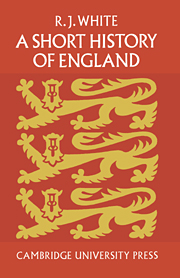Book contents
- Frontmatter
- Preface
- Contents
- Introduction: On the Character of English History
- 1 Roman Britain
- 2 Saxon England
- 3 The Anglo-Norman State
- 4 Common Law and Charter
- 5 The High Middle Ages
- 6 The Nation-State
- 7 The first Elizabethan Age
- 8 The Civil War
- 9 The Withdrawing Roar
- 10 The Century of Success
- 11 The first British Empire
- 12 The Age of Everything
- 13 War and Peace
- 14 Victorian Ages
- 15 Imperial and Edwardian
- Postscript
- Further Reading
- Index
7 - The first Elizabethan Age
Published online by Cambridge University Press: 14 November 2009
- Frontmatter
- Preface
- Contents
- Introduction: On the Character of English History
- 1 Roman Britain
- 2 Saxon England
- 3 The Anglo-Norman State
- 4 Common Law and Charter
- 5 The High Middle Ages
- 6 The Nation-State
- 7 The first Elizabethan Age
- 8 The Civil War
- 9 The Withdrawing Roar
- 10 The Century of Success
- 11 The first British Empire
- 12 The Age of Everything
- 13 War and Peace
- 14 Victorian Ages
- 15 Imperial and Edwardian
- Postscript
- Further Reading
- Index
Summary
It is a mistake to describe the Reformation in England as an act of state. The Breach with Rome was the act of state—a political, indeed, a revolutionary act, which had to come first if the reformation was to be undertaken with some degree of order and effectiveness. For the next hundred years, reformation was to be the leitmotiv of the English experience, and England was to be vastly more religious after the breach with Rome than it had been before it. Reformation was indeed the child of the modern state, not its parent. So was ‘the personal principle’, the notion of the individuated man. The Middle Ages were the ages of mass man. The nation-state provided the essential conditions for the growth of respect for individual personality.
Of course, there had been numerous signs and tokens of reformation in the religious life and practices of the English since the salt of the Catholic faith lost its savour in the days of the Avignon Papacy, the time when the friars turned priests into tramps and scroungers in the everyday experience of everyday men. John Wyclif (c. 1330–84), often known as ‘the Morning Star of the Reformation’, had left behind him the movement known as Lollardy, which challenged Church authority and order by appealing to Scripture. Lollardy had never died, and early in the reign of Henry VIII a number of incidents gave prominence to such abuses of clerical privilege as ‘benefit of clergy’, and revealed an anti-clericalism which went deep among all classes.
- Type
- Chapter
- Information
- A Short History of England , pp. 121 - 138Publisher: Cambridge University PressPrint publication year: 1967



